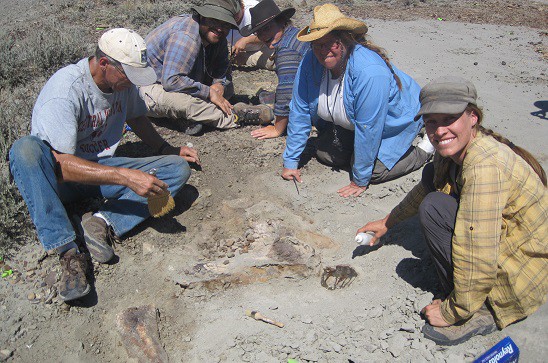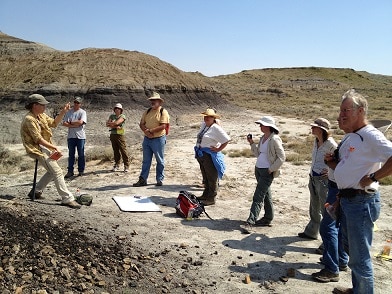Science Outreach with Teachers, Dinosaurs

A Unique Opportunity for Teachers
Last summer, in the heat of Montana’s badlands, a group of K-12 public school teachers went fossil hunting. They were part of the University of Washington/Burke Museums’s Discoveries in Geoscience Field School (DIG for short), and their mission was threefold: learn some fundamental geologic science and research methods (like how to keep a field notebook, use GPS, and interpret rock layers); contribute to UW paleontological research; and share their enthusiasm while bringing real science into their classrooms after returning home.
“It really changed how I viewed teaching.”
 “It really changed how I viewed teaching,” says 2012 DIG participant Jenny Toutonghi, an elementary teacher from Washington. “To be out there in the field and actually walk those hills… I’ve known [about geology and paleontology], I’ve read about that, but it was really different to experience it.” Jenny and ten other teachers from Washington and Montana spent four days in Hell Creek, an area famous for dinosaur fossils like Tyrannosaurus rex and Triceratops. Mornings and evenings included learning about geology, paleontology, research methods and use of equipment – nights around the campfire ranged from watching Jurassic Park projected onto the side of the cook tent to discussions about the extinction of dinosaurs. During the day, teachers and UW scientists quarried (dug in one spot) or prospected (walked around looking for fossils poking out of rock), while keeping detailed notes and measurements. They weren’t just looking for big dinosaurs – they also collected sediment to sieve for tiny fossils belonging to fish, turtles, and early mammals that scurried around the feet of dinosaurs.
“It really changed how I viewed teaching,” says 2012 DIG participant Jenny Toutonghi, an elementary teacher from Washington. “To be out there in the field and actually walk those hills… I’ve known [about geology and paleontology], I’ve read about that, but it was really different to experience it.” Jenny and ten other teachers from Washington and Montana spent four days in Hell Creek, an area famous for dinosaur fossils like Tyrannosaurus rex and Triceratops. Mornings and evenings included learning about geology, paleontology, research methods and use of equipment – nights around the campfire ranged from watching Jurassic Park projected onto the side of the cook tent to discussions about the extinction of dinosaurs. During the day, teachers and UW scientists quarried (dug in one spot) or prospected (walked around looking for fossils poking out of rock), while keeping detailed notes and measurements. They weren’t just looking for big dinosaurs – they also collected sediment to sieve for tiny fossils belonging to fish, turtles, and early mammals that scurried around the feet of dinosaurs.
Real Science in the Classroom
The fossils and data collected all help UW scientists investigate the extinction that ended the age of dinosaurs 66 million years ago. DIG teachers aren’t just adding to paleontology research – they’re a part of it. And they bring back real project-based knowledge and experience to their classrooms, along with unbeatable stories and photos from the field and infectious enthusiasm. Back in class, teachers have access to inquiry- and project-based activities and lesson plans that use the same science. Teacher can borrow the DIG Box, which includes teaching resources, real and replica fossils, and carefully crafted activities to support teachers’ curricula and the Next Generation Science Standards. Students can use the activities and evidence in the DIG Box to learn how rocks and fossils form or investigate the extinction of the dinosaurs themselves. They even have the chance to dig through sediment their teachers helped collect and identify fossils that they find.
Every teacher who participates in the DIG Field School has on-going access to UW paleontologists, research updates, and professional development resources. The DIG is free and teachers can receive continuing education clock hours. The application deadline has passed for the 2013 Field School, but it’s never too early to start thinking about next year! In the mean time, you can contact the DIG Field School at [email protected] to request lesson plans or a classroom visit from a UW paleontologist.
Disclosure: The author of this piece is a program assistant for the DIG Field School.







0 Comments
Leave a Comment
Your email address will not be published. All fields are required.